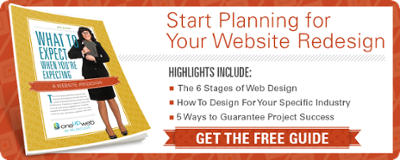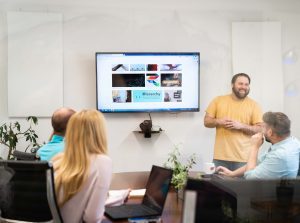33 Web Design Terms You Need to Know
HTML, CSS, CTA, RSS, RGB—it’s easy to be confused by the myriad of terms floating around the web. But, when it comes to designing and managing your website the more familiar you are with the jargon the better prepared you are to communicate with your team. For this reason we have compiled 33 need-to-know terms to help you on your journey though the roller coaster of web design.
404 Error – “File not found” code for a Web page that displays when a user attempts to access a URL that has been moved, renamed or no longer exists. Used as a template for missing or deleted pages, designing a custom “404 page” in a user-friendly way can help people stay engaged with your site even when a given page turns up blank.
Accessibility – On the web, accessibility refers to designing and building websites in such a way that it can be used by everyone regardless of their physical ability.
Branding – The look and feelings associated with a business represent its brand. For many businesses a brand includes visual elements such as a logo, color scheme, and fonts. On websites these brand elements are incorporated to ensure that the business’s online presence reflects, or even leads, the look and feel for the company.
Breadcrumbs — This term originates from the storybook world of Hansel and Gretel who upon adventuring into the woods left a trail of literal breadcrumbs behind them, so that they could find their way home. On the web breadcrumbs refer to any visual indicator that lets users know where they are and where they have been on the website.
Call to Action (CTA) —Typically, on a website a Call to Action asks users to perform a specific task such as ordering a product, filling out a form or downloading a whitepaper.
Cascading Style Sheets (CSS) — CSS is a markup language that sets up specific rules that govern what something looks like on a HTML webpages. For example if you want a paragraph on your website to be blue, you would change or add a rule to the CSS file of a website that would tell your browser to display the paragraph in a specific shade of blue.
Comp/Mock-Up —In the web design process a comp or mock-up refers to a “photograph” of what a webpage will look like after it is developed.
Content Management System (CMS) — A CMS is a platform used to publish and edit content. CMSs are often used to manage large websites, blogs, shopping and news sites. Common platforms include WordPress, Joomla, Drupal, and Magento.
Content – Any text, image, video, audio, app or other material published on the Internet for audience consumption.
Hashtag – A symbol (#) placed directly in front of a word or words to tag a post on Twitter, Facebook nd Google Plus. It is often used to group tweets by popular categories of interest and to help users follow discussion topics.
HTML – Hypertext markup language (HTML) refers to the text-based language which is used to create websites.
Hyperlink – Known as “link” for short, a hyperlink is a word or phrase which is clickable and takes the visitor to another Web page. This page can be within the same site or on a completely different site. Instead of a full URL string, a word or phrase is typically displayed in the body copy for the linked page (see “anchor text”), which can bring both reader and SEO benefits.
iFrames – Also known as simply “frames,” these HTML tag devices allow 2 or more websites to be displayed simultaneously on the same page. Facebook allows companies to create customized tabs for its fan pages using iFrames, a process which developers find much easier than using the previous “FBML,” or Facebook markup language.
+Java – Java is a powerful programming language which is independent of platforms, meaning it can run on multiple computers and operating systems.
+JavaScript – JavaScript is a relatively simple scripting language which can be seamlessly integrated with HTML and is used on many websites. JavaScript is less complex and consequently, less powerful than Java.
Landing Page – A stand-alone Web page that a user “lands” on, commonly after visiting a paid search-engine listing or following a link in an email newsletter. This kind of page often is designed with a very specific purpose (i.e. conversion goals) for visitors.
Microsite — A microsite, like its name suggests, is a small site with typically less than 5 pages that exists outside of a brand’s main website. Traditionally microsites are used to promote a single product or celebrate an event.
+Open-source Software – Computer software with a special license that allows users in the general public to edit and improve the source code.
Podcast – A series of audio or video content which can be downloaded and listened to/viewed offline.
Raster Image — Most images seen on the web are raster images. This type of image contains a set number of dots or pixels and cannot be enlarged without losing quality. Typical file formats for raster images are .jpg, .gif, .png and .psd.
Responsive Design —Responsive design is the action of designing and building a website so that page elements adapt and form to fit multiple devices ranging from traditional desktop computers to smartphones. Other terms for responsive design include fluid layouts & adaptive design.
RGB: RGB stands for the three colors—red, green & blue—which, when added together, make up the wide variety of colors seen on computer screens & televisions.
RSS – “Really simple syndication” is the process by which content such as blog posts or podcasts can be updated regularly and syndicated to subscribers in feeds. RSS feeds enable users to access content updates from various outlets—e.g. their favorite blogs, news sites, and digital audio/video providers—all in one central location.
Single-page website — Also referred to as a “brochure site.” Single- or one-page websites are a popular web design trend where the entire website is contained on a single web page. Traditionally a website contains many webpages that are linked together to create a website.
Sitemap — In terms of design a sitemap is a diagram that shows the structure and hierarchy of pages on a website.
Social Media – Refers to all online tools and places that are available for users to generate content and communicate through the Internet. These media include blogs, social networks, file-hosting sites and bookmarking sites, among others.
Style Sheet – A design template used for defining the layout of multiple pages within a website, most commonly seen in the form of “CSS” (cascading style sheets).
The Fold — On the web the fold has come to represent the imaginary line that divides the top area of the page when the user immediately sees upon loading the page and the bottom section that they must scroll to see.
UI (user interface) — The user interface is the means by which a human and a digital device interact. Common UIs include computer screens, keyboards, mice and touch screens. In webdesign the goal is to ensure that the user interface results in a positive and frustration free user experience.
URL – “Universal” or “uniform resource locator,” this string of letters and numbers separated by periods and slashes is unique for every Internet page. A page’s address must be written in this form in order to be found on the World Wide Web.
UX (user experience) Design — The process of enhancing satisfaction by improving on the aesthetics, functionality and ease of use provided in the interaction between the user and the website.
Vector Image — Unlike raster image which relay on pixels to define an image, vector images use computer algorithms to define path and shape. The advantage of this is that a vector image can be scaled to any size without losing quality. Typical vector formats include .ai, .eps and .svg.
Webinar – A Web-based seminar containing audio and video, often in the form of a slide deck.
Web font — A web font is a special font file that can be used on a website independently of font files loaded on a user’s device. Before the adoption of web fonts, websites were restricted to a short list of 12 font available on most computers. Popular sources for web fonts include Google Fonts, and Adobe Typekit.
Wiki – Refers to any page or collection of pages on the Internet or an intranet that can be easily edited by the public or a select group of registered visitors. Wikis are examples of collaboration. See “Wikipedia,” the most famous example of a wiki, below.
Wireframe —A wireframe is like a blueprint for a webpage design, it depicts the hierarchy and placement of elements on a webpage.
Are there any terms we missed?
What other web design jargon confuses you? Leave a comment below.

